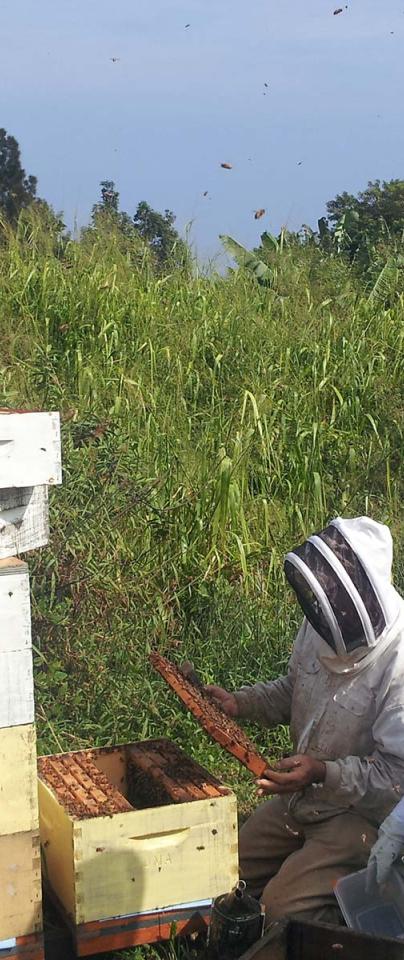Moku virus highlights potential threat to pollinators worldwide
We help identify invasive species virus which could threaten global pollinator health - particularly under threat are honey bees, who are vital to our food systems.
Pests and disease are spreading throughout the planet in an increasingly rampant manner, leaving our agriculture under threat due to the loss of economically important animals. Particularly under threat are honey bees, which are prone to a suite of emergent diseases, including Moku, a virus recently isolated in Hawaii.
Honey bees are as vital to our food systems as the crops they pollinate; with a swathe of economically important plants relying directly on bees for propagation. A recent study published in Nature highlighted a novel potential threat to these key creatures: an iflaviurscommon to wasps, bees and varroa mites, featuring the work of Purnima Pachori of Earlham Institute’s Platforms & Pipelines Group.


moku-virus-highlights-potential-threat-to-pollinators-worldwide-collecting-samples.jpg

Instances of emerging infectious diseases are well documented, including the numerous Deformed Wing Viruses (DWV), which characteristically can infect a range of hosts and are particularly detrimental to social insect species.
Instances of such viruses have been known to wipe out entire colonies, and owing to their broad host range, can easily jump between reservoirs of insects.
A new paper, published in Nature, describes the sequencing of a novel single-stranded RNA virus – named Moku after the Island from which it was isolated - in the invasive wasp species, Vespula pensylvanica .
Complementary DNA (cDNA) sequencing was performed at Earlham Institute on the Illumina HiSeq, from which the novel viral genome of 10,056bp (base pairs) was sequenced and assembled from eight wasp individuals, whose closest relative was found to be the Slow bee paralysis virus.
Purnima Pachori at EI performed the QC and assembly of viral samples from honey bees, V. pensylvanic and the varroa mite. Crucially, she was able to clean up the insect and mite-specific RNAs to leave only viral sequence for analysis, which allowed for the identification of the novel Moku virus - led by Gideon Mordecai of the Marine Biological Association, Plymouth.
“De novo assembly of viruses from a metagenomic sample is challenging because of intrapopulation variation and uneven or insufficient coverage, however, freely available assemblers such as Vicuna, MEGAHIT and our in-house assembler MetaCortex enable us to assemble host free reads in a timely and cost -effective manner,” said Purnima.
“It’s brilliant that I could contribute to the phylogenetic characterisation of a new virus which can be a threat to pollinator health worldwide, and bioinformatics tools such as MEGAN and BLAST provide a fantastic support for taxonomic analysis.”
Within the Moku genome, a 9153 ORF (open reading frame) was detected using BLASTx, encoding a 3,050 amino acid polyprotein, with the constituent proteins and 3C protease enzyme sites adhering to a structure typical of iflaviruses.
Variation between strains of Moku across the wasp samples studied was small (98% sequence identity across all sequences), however, like DWV, it is likely Moku exists as a cloud of variants, all derived from a master variant specific to a certain species.
Additionally, comparison of sequences encoding the RNA dependent RNA polymerase, helicase and VP3 consensus regions were matched across samples taken from A. mellifera and Varroa destructor, which were also known to carry the Moku virus.

Big Island in Hawaii, where several samples were taken.
The report has highlighted the importance of monitoring invasive species for broad-range viruses as well as the potential for transmission of these pathogens.
The likelihood is that Moku has the ability to spread throughout the population of honey bees in Hawaii; with viral load measurements suggesting the origin is indeed Vespula pensylvanica.
Moku is closely related to the slow bee paralysis virus, which itself is found in the UK, Fiji and Western Samoa, therefore, it is likely that Moku also has the capacity to ground itself in a variety of locations globally.
The identification of Moku virus in Varroa mites, too, is of particular concern - especially with their well-documented role in the transmission of other RNA viruses. One fear is that once established among Varroa mites, an epidemic-scale transmission of Moku virus throughout honey bee populations is a distinct possibility.
All in all, the study highlights that cross-species transmission of RNA viruses, especially from invasive species which can spread viruses to new locations, is a threat to pollinator health worldwide.
Gideon Mordecai from the Marine Biological Association, first author on the paper, said, “The use of next generation sequencing has led to a rapid increase in virus discovery, and is a powerful tool for investigating the enormous diversity of viruses out there. Future challenges will be assessing the biological relevance of these novel pathogens and the role they play in the ecology of their hosts.”
Reach
posts sent across social media
impressions across social media
clicks through to our website
Engagement
engagements across social media
engagement rate
shares across social media